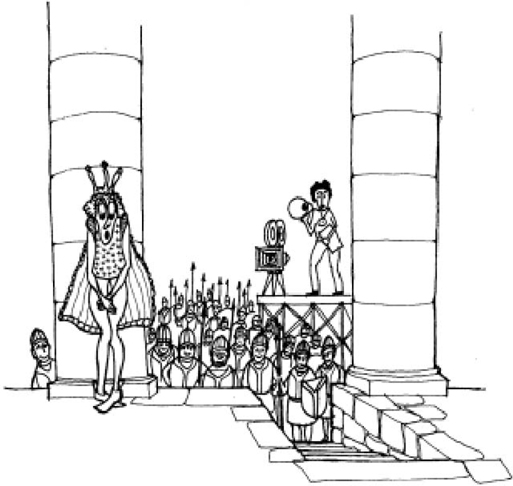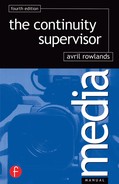Checking
Once you have established continuity on a shot that has been taken then any shot that, in the final edited version, will cut into or onto that shot will need to match for continuity.
In matching continuity, therefore, you are not so much involved in writing fresh notes but in checking. You check the artists’ costume against your notes and photographs; you check the props against your drawings. You check that the camera angle is not going to cross the line so that objects and people jump in frame. During the rehearsals and the shooting you check the dialogue and that the actors’ actions are the same and happen at the same time in relation to the dialogue as the shot already taken. In other words, you are not busy writing down fresh notes, unless there is new material being rehearsed and shot, but you are using those you have already made in order to match continuity.
If an Actor Gets it Wrong
Never go directly to the artist and point out continuity errors without first speaking to the director. It is discourteous to the director, who is ultimately responsible for accepting the actor’s interpretation and performance. The continuity might have been wrong but the performance so stunning that the director might not wish to retake the shot but decides to get round the continuity problem in other ways. There might not be time to retake for continuity or the director might know that the specific continuity error is unimportant. You must always speak to the director first.
If you are then asked to tell the actor, always go up to him or her with the script and explain the problem quietly, showing the actor the script. It is very confusing to the actor if you shout across the set from your position by the camera.
If the Director Won’t Listen
There is nothing you can do in the situation where a director won’t listen or ignores a point of continuity which you feel to be important, except note on the continuity report sheet that the continuity was wrong. That could prove helpful to the editor.
Which ‘Take’ Do you Match for Continuity?
Let us say you have shot six takes on one particular angle. The director thinks that take 1 is possible and so is take 6. The continuity on those takes differs, and you are about to shoot another shot which has direct continuity with the one just recorded. You ask the director which take he prefers, in order to match continuity. The director will not, or cannot, specify, saying that he will look at both takes in the editing. Do you match continuity to take 1 or take 6?
As the director has not spoken in favour of either take, it is then up to you to decide which to match for continuity. I would always match continuity to the last take (take 6 in this example), as the artists are far more likely to remember how they performed five minutes ago rather than two hours ago. Also, the last take must have been satisfactory enough for the director to move on to another shot.

‘If you are then asked to tell the actor, always go up to him and explain the problem quietly.’
